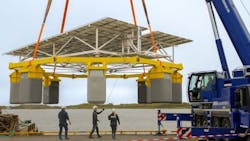Saipem starts Xolar floating solar energy trial in Norwegian fjord
Saipem and its partners have developed the first full-scale prototype of the harsh-offshore environment floating solar energy system XolarSurf.
The floater, created with manufacturer Kystteknikk and other subcontractors, was launched at sea at Kystteknikk's site in Dyrvik on the island of Frøya, at the mouth of the Trondheim fjord in Norway.
It is designed to withstand waves of up to 8 m in height. It is due to remain at sea for about a year, with its performance and production capacity constantly monitored.
Saipem’s Norwegian subsidiary Moss Maritime developed the modularized floating solar technology. The industrialization process that followed was designed to assess the potential cost reductions associated with repeated and scalable production.
It involved years of development, engineering, model and component testing in laboratories and full-scale testing of marine operations required for installation of an offshore floating solar park, under a collaboration with Equinor.
XolarSurf can produce electricity from solar panels mounted on floaters engineered for marine environments. It comprises various "islands" that each feature several smaller floaters supporting the photovoltaic panels, and each generating up to 35-45 kWp of installed power.
According to Saipem, XolarSurf can be installed at any coastal or offshore location, even in harsh environmental conditions. It could also provide a solution for hybrid projects, such as offshore wind farms, both fixed and floating.
The technology is said to be especially suited to locations with limited access to land, remote areas and standalone grids, and it could provide electricity to the burgeoning aquaculture industry, both close to the shore and for new planned offshore installations.
Its modular design allows for relatively straightforward relocation to new sites or expansion of its existing location, Saipem added.
